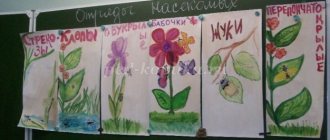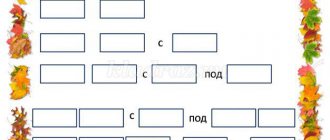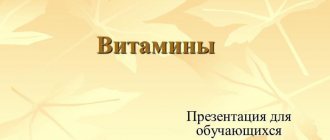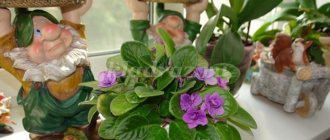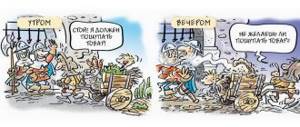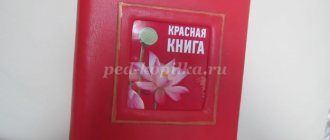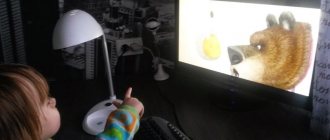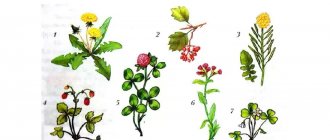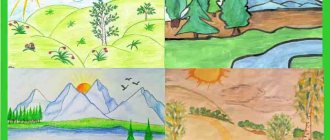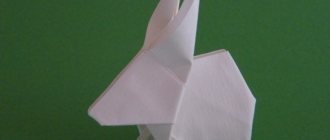Presentation “Journey to the Forest”
- May 3, 2013
Competition "Master of Multimedia Technologies - 2013"
Nomination "Multimedia technologies in the pedagogical process in preschool educational institutions"
Goal : systematize and deepen children’s ideas about the forest, in particular about trees: birch, pine, spruce.
Tasks:
Educational:
- To consolidate and deepen children's knowledge about spruce, pine and birch as representatives of the wildlife of our region.
- Learn to analyze natural objects (trees), identify essential features (trunk, branches, leaves).
- Introduce children to new concepts: pine forest, birch grove, spruce forest, mixed forest.
Educational:
- Develop children's thinking, memory, curiosity;
- To develop the ability to compare these trees, to see similarities and differences between them;
- Develop cognitive and research activities;
- Develop children's play activities.
Educational:
- Foster a caring attitude towards nature.
Practical significance: this presentation allows you to include the child in the learning process and keep his attention. An animated owl and a physical exercise for the eyes “revive” the material being studied and make the learning process more interesting and exciting. The presentation solves the problem of lack of visual aids.
Place of use of multimedia material : the presentation is used in direct educational activities.
Outline of the educational activity "Journey to the Forest"
Direct educational activities take place in the form of an excursion. The excursion to the forest is accompanied by a teacher as a guide and an animated Owl. We explore trees: birch, pine, spruce.
Target
: Systematization and deepening of children’s ideas about the forest, in particular about trees: birch, pine, spruce.
Tasks:
Educational:
- Learn to analyze natural objects (trees), identify essential features (trunk, branches, leaves);
- To consolidate and deepen children’s knowledge about spruce, pine and birch as representatives of the wildlife of our region;
- Introduce children to new concepts: pine forest, birch grove, spruce forest, mixed forest.
Educational:
- Develop imagination, thinking, memory, curiosity of children;
- To develop the ability to compare these trees, to see similarities and differences between them;
- Develop cognitive, research and productive activities;
- Develop children's play activities.
Educational:
- Foster a caring attitude towards nature;
- Repeat and consolidate knowledge about road safety rules as a passenger;
- Form a conscious need for physical activity.
Integrated educational areas:
cognition, communication, safety, socialization, physical education.
Types of children's activities:
communicative, motor, cognitive-research, productive.
Forms of working with children:
conversation, game, examination, posing a problematic question, drawing.
Organizational form:
subgroup.
Material:
laptop, projector, presentation and music files (sounds of the forest, sound of a starting engine), electronic physical exercises, seat belts, twigs and fruits of trees (birch, spruce, pine), coloring book and stickers for it.
GCD move
1 slide.
Surprise Moment – Owl Greeting
The teacher enters as a guide.
— The Owl sent me to you to accompany you on a virtual excursion. How should we go on an excursion? (Children's options). Let's take some chairs and build our bus.
Let's take a seat.
— Guys, do you know the first and most important rule of a passenger?
Let's buckle up.
The sound of the engine sounds.
— Guys, in order to better see the beauty of our native nature, I suggest doing gymnastics for the eyes.
Slide 2.
Gymnastics for the eyes.
The owl speaks, the guide shows
.
The sounds of the forest are heard.
- Guys, what is this? What sounds? Where do you think such sounds can be heard? ( In the woods).
The sounds tell us that we have arrived in the forest.
We go out and settle down, as it is convenient for the children .
Guys, it seems to me that the Owl wants to tell us something.
Slide 3
. Let's guess the riddle.
Slide 4.
The owl asks a question.
We introduce the concept of birch grove.
Cognitive - research activities. Children feel the twigs and seeds of the tree.
We talk about birch (
distinctive features)
-
Looks like Owl guys still wants to give us a riddle.
Slide 5.
The riddle about the spruce
.
Slide 6.
Owl's question.
We introduce the concept of spruce forest.
Cognitive - research activity. Children feel the twigs and seeds of the tree.
We talk about spruce.
—
Guys, aren't you tired? let's get up and carry out the actions that the Owl tells us.
Slide 7.
Physical exercise.
—
We sit down more comfortably, Sovushka will ask us another riddle.
Slide 8.
Riddle about the pine tree.
Slide 9.
We introduce the concept of
pine forest.
Cognitive - research activity. Children feel the twigs and seeds of the tree.
We are talking about pine.
Slide 10.
Picture of a mixed forest.
- Children, please look at the picture that Owl shows us, what trees are shown in it? Tell me, what is the name of this forest?
Slide 11.
The owl introduces the concept of
mixed forest
- Why do you think it is called that?
Slide 12.
Repetition of new concepts. Game "Guess the Forest".
Slide 13.
Farewell to the Owl.
— The excursion has come to an end, we are returning to the kindergarten. Guys, while we are driving back, I will give you a gift from Owl. Let's go on the bus.
They are taking their seats,
the sound of a starting engine sounds
, the guide hands out coloring books.
– Guys, what did you see on the virtual tour today?
— Problematic question: What would happen if there were no trees? Why do we need to protect nature?
– What would you like to talk about at home today?
- Guys, well, we’ve arrived, it’s time to say goodbye. I invite you to come out. I really enjoyed being your tour guide. As a parting gift, I give you a musical and dance gift. Look at the characters on the screen and repeat their movements.
Interactive physical training
"Spring came".
Appendix 1: Presentation.
Appendix 2: Outline.
Author: Kosolapova Lyudmila Nikolaevna, teacher, MBDOU No. 21, Krasnoyarsk.
Lesson summary “Forest - multi-storey building”
MBDOU No. 5 “Scarlet Flower”, Tikhoretsk, Krasnodar Territory
Educator
Winner (1st degree diploma) of the All-Russian competition for teaching staff of preschool organizations “Best lesson notes in kindergarten”
Link to the article, when indicated in the bibliography (according to GOST R 7.0.5-2008):
Posokhova S.B. Lesson summary “Forest - multi-storey building” // Sovushka. 2020. N1. URL: https://kssovushka.ru/articles/e-sovushka.2015.n1.00010.html (access date: 10.10.2020).
Goal: to clarify and expand children’s ideas about the forest and its inhabitants.
Tasks :
- give children an initial idea that a forest is a multi-storey building in which many plants and animals live on different “floors” (tiers), which find food, places for nests, and burrows in it;
- show the multi-tiered nature of the forest;
- identify and enrich children’s ideas about the importance of forests in human life;
- give children an idea of a forester - a person who takes care of the forest: protects from fire, feeds animals in winter, saves some of them from harm;
- develop children's cognitive interest, respect for nature, and correct behavior;
- to cultivate interest in nature, the ability to see its beauty, the desire to preserve all living things.
Preliminary work:
- conversation about the forest;
- examination of illustrations depicting the forest and the album “Beasts of the Forest”;
- learning proverbs about the forest;
- guessing riddles about forest animals;
- looking at illustrations depicting a forester.
Materials:
- model “floors of the forest”, pictures depicting trees, bushes, mushrooms, berries, forest inhabitants;
- tables; pictures “How a forester takes care of the forest”, “Rules of conduct in the forest”, “Why do people go to the forest.”;
- musical accompaniment.
Methodological techniques : asking riddles, playful actions of placing animals on the floors on the diagram, filling out tables, asking questions to children, assessing and rewarding, listening to musical recordings, viewing slides.
Equipment: multimedia installation, tape recorder.
PROGRESS OF THE CLASS
Educator: Guys, today we will go on a trip in a hot air balloon, and you will find out where along the way (the teacher offers to take the children’s seats). While we are flying, I will tell you a riddle, and you will guess where we will go.
The hero is rich and treats all the children: Vanya with strawberries, Tanya with stone fruits, Mashenka with nuts, Petya with russula, Katenka with raspberries, Hooligan with twigs.
Children : into the forest. Educator: that's right, this is a forest. While you and I are flying into the forest, let's see how many interesting things you can see (view multimedia slides, ask the children how everything looks from above, bring up the fact that from a height everything seems small, only the roofs of houses are visible) Educator : Listen ... Hear the breeze playing with the leaves. But the voices of birds were heard (the voices of birds sound) Do you hear? Xin-xin-xin is the song of a tit, cha-cha-cha is a magpie, chiv-chik-chik-chirik is a sparrow. We are approaching the forest (music sounds). Children, can we say that we heard the voice of the forest? Why? (children's answers) Educator: Now we have arrived in the forest, let's get out of the balloon. Hello, forest, dense forest, full of fairy tales and miracles. Look how many trees, mushrooms, and bushes there are in the forest. How many colors... Red, burgundy color can be found in mushroom caps and ripe lingonberries and cranberries. Yellow and orange colors are given by forest daisies and butterflies. You will find the color green in grass, leaves and mischievous grasshoppers. Blue - in the expanses of heaven and clear waters. The blue color is hidden in forest clearings in cornflowers and bluebells. And the purple color is about to fly away on the wings of a beetle (Slides showing a forest on a multimedia installation are shown). Educator : Who do you think are the most important inhabitants of the forest? Children : trees Educator: That's right, trees. What trees grow in the forest? (slides with images of trees are shown and their names are clarified). Educator: Guys, here are pictures of trees, try to name them (the children name the trees, the teacher asks how they knew that it was birch, oak, spruce, etc.) Educator: What else grows in the forest? (children's answers: bushes, berries, mushrooms, grass...) Educator: Who do you think needs trees, grass, shrubs and mushrooms and why? (children's answers: animals, birds, insects...) Educator: That's right, different animals live in the forest: animals of prey (wolf, fox, bear, lynx), forest birds (magpie, nightingale, owl, woodpecker), insects (ants, beetles) , caterpillars, mosquitoes). Educator: Can a forest be called a multi-story building? (children’s answers) Educator: Let us now create your own forest (a picture of a forest is assembled on the panel) Educator: Now let’s compare the forest with a multi-story building (a table with a picture of a multi-story building is inserted into the table-panel “Forest”, a line is drawn from each floor , passing through the panel) Educator: What grows on the first floor? (children's answers: grass, mushrooms, flowers....) Educator: What grows on the second floor? (children's answers) Educator: That's right, the next floor is occupied by smaller bushes and trees, and the topmost floor is occupied by tall oaks and pines. All floors are inhabited by forest inhabitants. Tell us which forest inhabitants live on which floor? (children's answers) Educator: A forest is like a large multi-story building. There are many, many tenants and neighbors living there. They all need each other (Slide show - multi-tiered forest) Educator: Guys, which of you lives in a multi-story building? (children's answers) Educator: Now you know that not only a house, but also a forest can be multi-story (check with the children what grows and who lives on different floors of the forest) Educator: Do you think a person needs a forest? (children's answers) Educator: The forest is a wonderful natural resource. People go there not only to pick mushrooms and berries, they go to the forest to relax, enjoy the silence, coolness, clean air, birdsong, forest rustles (work with a table - children are offered pictures, from which they need to choose those that show why a person goes to the forest Children choose pictures and paste them into the table) Educator: Children, do you think the forest can be offended? (children's answers) Educator: A plaintive book of the forest fell into my hands. (children look at a book of complaints, the teacher reads out complaints from flowers, birds, etc.) Educator: How can you help the forest? (children's answers) There are pictures on the table depicting what should not be done and how you can help. Educator: I have prepared 2 tables for you: on one the flower is smiling, and on the other it is sad. Why do you think? (children's answers: the flower is sad - this should not be done in the forest, smiles - how can we help the forest). Educator: Let's choose pictures for ourselves and fill out the tables. (Children fill out a table about the rules of conduct in the forest) Educator: Well done! Remember these rules and follow them. Guys, we told you that the forest is a big house. Every house has an owner. Do you know who is the main owner in the forest? (children's answers) Educator: That's right, the main person in the forest is the forester. He knows all the inhabitants of the forest well and tries to help them in difficult times. He makes sure that the trees do not get sick, extinguishes forest fires and plants new trees to replace those cut down. There are not so many foresters in our country; the work of a forester is difficult and sometimes dangerous. He lives in the forest far from the city. Let's see how a forester takes care of the forest (look at the table). Educator: Guys, think about whether ordinary people can help the forest and forest inhabitants? How? (children's answers) Educator: Well done. You and I talked a lot about the forest, its inhabitants, the rules of behavior in the forest, the necessity of the forest for people, and the work of a forester. And now it’s time for us to say goodbye to the forest:
Dense forest, goodbye! You will grow to the joy of people! We will be friends with you, kind forest, mighty forest, Full of fairy tales and miracles!
Educator: Let's get into our balloon and go back to kindergarten (children take their seats). Educator: In the meantime, tell me why the forest is called dense and mighty? (children’s answers) Educator: What does it mean “you will grow up to please people”? Educator: Why do you think the forest is full of fairy tales and miracles? (children’s answers) Educator: You and I didn’t notice how we arrived (children get out of the balloon). We are back in kindergarten. Educator: Did you like our trip? What did you like most? (children's answers) Educator: Now you know that a forest is a multi-story building in which many plants and animals live on different “floors” and find food, places for nests, and burrows in it. You know the rules of behavior in the forest and that the main person in the forest is the forester.
